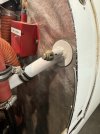- Joined
- Feb 23, 2005
- Messages
- 11,186
- Location
- Lone Jack, MO
- Display Name
Display name:
Greg Bockelman
Generally accepted practices for installing bolts is to follow the “IDA” philosophy. In, Down, or Aft. On my motor mount, the bolts through the firewall were installed from the inside, opposite of that. I kind of like that idea because they are easily looked at during preflights.
The manuals have no guidance on this. What say you? Nuts on the cabin side or engine side?
The manuals have no guidance on this. What say you? Nuts on the cabin side or engine side?

